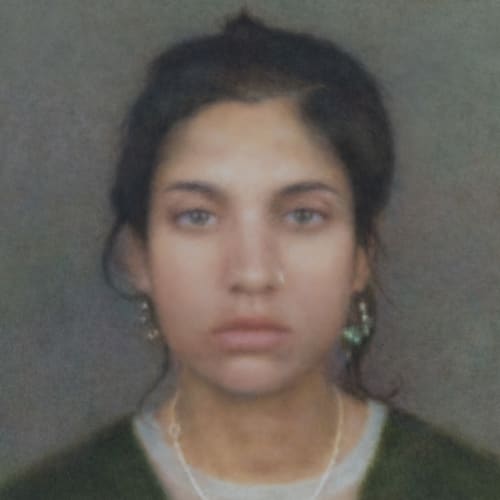조현화랑은 2025년 8월 29일부터 10월 26일까지 이광호 개인전 〈시선의 흔적 Traces of Gaze〉를 개최한다. 이번 전시는 작가가 20여 년 만에 다시 선보이는 초상화 8점과 2023년부터 이어온 <Blow-Up> 프로젝트 76점을 포함해 총 90여 점을 공개하며, 이광호의 30년 작업 세계를 관통하는 핵심적 화두인 '시선'의 문제를 집약적으로 보여준다.
이광호는 2006년 창동스튜디오 레지던시에서 발표한 <Inter-View> 프로젝트 이후 처음으로 초상화 작업에 복귀한다. 이번 초상화 시리즈는 핀홀 렌즈라는 원시적 광학 장치를 통해 포착된 흐릿하고 불완전한 이미지를 바탕으로 제작되었다. 낮은 해상도와 미세한 흐림, 깊은 심도를 특징으로 하는 핀홀 렌즈는 긴 노출 시간을 필요로 하며, 이 느린 시간의 흐름 속에서 대상의 미세한 변화가 한 장의 이미지에 담기게 된다. 완벽한 재현을 거부하며 더듬거리며 이어 나간 듯한 붓질들이 쌓인 화면은 시각과 촉각이 교차하는 지점을 통해 캔버스를 촉지성의 공간으로 변화시킨다.
2017년 뉴질랜드 여행으로부터 영감을 받아 제작되기 시작한 <Blow-Up> 프로젝트 또한 이광호의 작업 방법론인 촉각적 회화 기법을 반영한다. 작가는 수천 장의 습지 사진을 참고하여, 촉촉하게 적신 캔버스 위에 붓질을 하고, 판화용 니들로 밝은 부분의 라인을 긁어내며, 고무붓으로 흰색 이끼 부분을 표현하는 등 이미지의 경계를 해체하면서도 밀도감을 높인다. 특히 뿌리기 기법은 유화물감을 캔버스에 뿌려 붓과 표면의 접촉을 차단함으로써 이미지가 쾌활하고 시원해지는 효과를 만들어낸다.
이번 전시에서는 총 76점의 <Blow-Up> 연작이 19열 4줄로 배열되어 18미터 벽면을 가득 메우며 하나의 거대한 파노라마 이미지를 형성한다. 화가가 한 장면을 캔버스 안으로 분절해 제시하는 선택과, 이를 다시 이어보는 관람자의 시선이 교차하는 다층적 구조 속에서, 관람자는 다시금 외부의 창과 내부의 전시장을 함께 조망하는, 자연과 회화의 빛 사이에 놓인 초상화와 마주한다. 외부의 시선을 망각한 듯한 모습을 담아낸 초상화들은 자아와 대상의 경계가 흐려지는 공간으로 초대한다. 바다를 향해 열린 조현화랑_달맞이의 대형 유리창과 18미터 벽면이라는 물리적 조건은 작가로 하여금 공간을 하나의 거대한 시각 장치로 인식하게 했다. 실제 시선과 매개된 시선이 교차하는 이 공간에서 이광호는 회화가 시선을 통해 완성되는 예술임을 보여준다.
1967년생 이광호는 전통적 회화 기법과 현대적 기술을 적극 활용하며 모더니즘 이후 양분된 서사와 비서사 회화의 경계를 넘나드는 작업을 해왔다. 1996년 첫 개인전에서 시작된 그의 화두는 사랑하는 사람과 마주보지 못한 자신의 체험을 바탕으로 한 애정표현의 한계를 다뤘고, 2001-2003년 '가족' 시리즈, 2005년 <Inter-View>시리즈를 거쳐 2006년부터 시작된 선인장 시리즈까지 일관되게 '내 안의 욕망'이라는 주제를 탐구해왔다. 나이와 함께 변화하는 신체 감각, 특히 눈의 감각을 정면으로 마주하게 된 작가는 "애무하듯 그린다"고 표현했던 자신의 붓질이 시각과 촉각의 전이를 통해 감각을 증폭시키는 과정임을 깨닫는다. 이광호에게 이미지는 손으로 회화의 표면을 문지르는 촉각적 노동의 과정 속에서 서서히 드러나는 시선의 흔적(traces)이다.
Johyun Gallery presents Traces of Gaze, a solo exhibition by Lee Kwang-Ho, from August 29 to October 26, 2025. Featuring more than ninety works, including eight new portraits—his first in two decades—and seventy-six paintings from the ongoing BLOW-UP project (2023–), the exhibition offers a focused insight into the central theme that has shaped Lee’s thirty-year artistic journey: the nature of gaze.
Lee Kwang-Ho returns to portraiture for the first time since his Inter-View series at the Changdong Studio residency in 2006. He employs a pinhole lens to create blurred and imperfect images in his latest portraits. The rudimentary optical device produces low-resolution, subtly diffused visuals while also creating greater depth through its long exposure. Within this slow passage of time, a single frame captures a subject’s delicate changes. Lee’s canvases, layered with brushstrokes that seem to feel their way forward, resist precise representation and transform the surface into a tactile space where sight and touch converge.
BLOW-UP, inspired by his 2017 trip to New Zealand, also embodies Lee’s distinctive tactile approach to painting. Over the course of approximately five hours of intensive work, referencing thousands of wetland photographs, the artist applies brushstrokes to a dampened canvas, scratches out lines in bright areas with etching needles, and renders white moss sections with rubber brushes. Through the process, the artist deconstructs the contours in the image while enhancing the overall sense of density. Notably, the spattering technique—flicking oil paint onto the canvas without brush contact—imparts a vibrant, crisp visual effect.
In this exhibition, seventy-six paintings from the BLOW-UP series fill an 18-meter-long wall in a four-by-nineteen arrangement, forming a single monumental image. Within the multi-layered structure where the artist’s choice to fragment a single scene across the canvases and the viewer’s re-assembling gaze intersect, viewers this time encounter the portraits installed between natural light and painted light, positioned to overlook both the gallery’s windows and the interior exhibition hall. These portraits, seemingly oblivious to the external gaze, invite the viewer into a space where the boundaries between self and subject blur. The Johyun Gallery_Dalmaji leverages its physical conditions—large glass windows facing the ocean and an 18-meter-long wall—to enable the artist to treat the space as a vast visual installation. Within this space where actual gaze and mediated gaze intersect, Lee Kwang-Ho demonstrates that painting is an art completed through the act of seeing.

